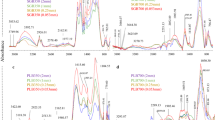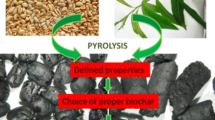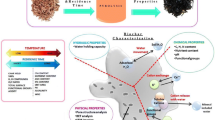Abstract
Willow, a leading bioenergy feedstock, may be planted for bioremediation and has been used, more recently, as the biomass feedstock in the manufacture of biochar for agricultural applications. Here, we present a detailed study of the physical and chemical factors affecting willow char properties, where the feedstock is a by-product of bioremediation, potentially transferring pollutants such as heavy metals to the wood feed. Biochar samples were produced via pyrolysis of short-rotation coppice willow, grown on contaminated land, using several treatment times at heat treatment temperatures (HTTs) in the range 350–650 °C, under a constant flow of argon, set at either 100 or 500 mL min−1. The samples were analysed for yield, elemental analysis and structural characteristics, including surface area and pore size distribution, surface functionality and metal content. All chars obtained have high fixed carbon contents but vary in surface characteristics with a marked increase in basic character with increasing HTT, ascribed to the removal of surface oxygen moieties. Results indicate a minimum pyrolysis temperature of 450 °C is required to produce a defined mesoporous structure, as required to facilitate oxygen transport, HTT ≥ 550 °C produces total surface area of >170 m2 g−1 and, more importantly, an appreciable external surface area suitable for microbial colonisation. The data show that selection and optimisation of char properties is possible; however, the interplay of factors may mean some compromise is required.


Similar content being viewed by others
References
Sohi SP, Krull E, Lopez-Capel E, Bol R (2010) A review of biochar and its use and function in soil. Adv Agron 105:47–82
Atkinson CJ, Fitzgerald JD, Hipps NA (2010) Potential mechanisms for achieving agricultural benefits from biochar application to temperate soils: a review. Plant Soil 337:1–18
Ennis CJ, Evans AG, Islam M, Ralebitso-Senior TK, Senior E (2012) Biochar: carbon sequestration, land remediation and impacts on soil microbiology. Crit Rev Environ Sci Technol 42:2311–2364. doi:10.1080/10643389.2011.574115
Woolfe D, Amonette JE, Street-Perrott FA, Lehmann J, Joseph S (2010) Sustainable biochar to mitigate global climate change. Nat Commun 1:56. doi:10.1038/ncomms1053
Pacala S, Socolow R (2004) Stabilization wedges: solving the climate problem for the next 50 years with current technologies. Science 305:968–972
Roberts KG, Gloy BA, Joseph S, Scott N, Lehmann J (2010) Life cycle assessment of biochar systems: estimating the energetic, economic and climate change potential. Environ Sci Technol 44:827–833
Hossain MK, Strezov V, Yin Chan K, Nelson PF (2010) Agronomic properties of wastewater sludge biochar and bioavailability of metals in production of cherry tomato (Lycopersicon esculentum). Chemosphere 78:1167–1171
van Zwieten L, Kimber S, Morris S, Chan KY, Downie A, Rust J, Joseph S, Cowie A (2010) Effects of biochar from slow pyrolysis of papermill waste on agronomic performance and soil fertility. Plant Soil 327:235–246
Headlee WL, Brewer CE, Hall RB (2013) Biochar as a substitute for vermiculite in potting mix for hybrid poplar. Bioenerg Res. doi:10.1007/s12155-013-9355-y
Peng X, Ye LL, Wang CH, Zhou HBS (2011) Temperature- and duration-dependent rice straw-derived biochar: characteristics and effects on soil properties of an ultisol in Southern China. Soil Tillage Res 112(2):159–166
Dickinson NM, Baker AJM, Doronila A, Laidlaw S, Reeves RD (2009) Phytoremediation of inorganics: realism and synergies. Int J Phytoremediation 11(2):97–114
Karami N, Clemente R, Moreno-Jimenez E, Lepp NW, Beesley L (2011) Efficiency of green waste compost and biochar soil amendments for reducing lead and copper mobility and uptake to ryegrass. J Hazard Mater 191(1-3):41–48
Gomez-Eyles JL, Sizmur T, Collins CD, Hodson ME (2011) Effects of biochar and the earthworm Eisenia fetida on the bioavailability of polycyclic aromatic hydrocarbons and potentially toxic elements. Environ Pollut 159(2):616–622
Bird MI, Ascough PL, Young IM, Wood CV, Scott AC (2008) X-ray microtomographic imaging of charcoal. J Archaeol Sci 35:2698–2706
Abdullah H, Wu H (2009) Biochar as a fuel: 1. Properties and grindability of biochars produced from the pyrolysis of mallee wood under slow-heating conditions. Energy Fuel 23:4174–4181
Agblevor FA, Beis S, Kim SS, Tarrant R, Mante NO (2010) Biocrude oils from the fast pyrolysis of poultry litter and hardwood. Waste Manag 30:298–307
Gaskin JW, Steiner C, Harris K, Das KC, Bibens B (2008) Effect of low-temperature pyrolysis conditions on biochar for agricultural use. Trans ASABE 51:2061–2069
Brunauer S, Emmett PH, Teller E (1938) Adsorption of gases in multimolecular layers. J Am Chem Soc 60:309–319
Boateng AA (2007) Characterization and thermal conversion of charcoal derived from fluidized-bed fast pyrolysis oil production of switchgrass. Ind Eng Chem Res 46:8857–8862
Brewer CE, Schmidt-Rohr K, Satrio JA, Brown RC (2009) Characterization of biochar from fast pyrolysis and gasification systems. Environ Prog Sustain Energy 28:386–396
Sheldon RA (2008) Why green chemistry and sustainability of resources are essential to our future. J Environ Monit 10(4):406–407. doi:10.1039/b801651h
Kwapinski W, Byrne CMP, Kryachko E, Wolfram P, Adley C, Leahy JJ, Novotny EH, Hayes MHB (2010) Biochar from biomass and waste. Waste Biomass Valorization 1(2):177–189
Free HF, McGill CR, Hedley MJ (2010) The effect of biochars on maize (Zea mays) germination. N Z J Agric Res 53(1):1–4
Lord RA, Atkinson J, Lane AN, Scurlock JMO, Street G (2008) Biomass, Remediation, re-Generation (BioReGen Life Project): Reusing brownfield sites for renewable energy crops. In: Khire MV, Alshawabkeh AN, Reddy KR (eds) GeoCongress 2008: Geotechnics of Waste Management and Remediation, vol 177. American Society of Civil Engineers Geotechnical Special Publication, pp 527–534
Lord RA, Atkinson J, Scurlock MO, Lane AN, Rahman PKSM, Connolly HE, Street G (2007) Biomass, Remediation, re-Generation (BioReGen Life Project): Reusing brownfield sites for renewable energy crops. In: Energies ER (ed) 15th European Biomass Conference & Exhibition, Berlin, Florence, Italy ETA-Florence, Italy and WIP-Munich, Germany
Stern N (2006) Stern review on the economics of climate change. HM Treasury, London
IPCC (2007) IPCC 4th Assessment Report: Climate Change 2007
Ross AB, Junyapoon S, Jones JM, Williams KD, Bartle J (2005) A study of different soots using pyrolysis-GC-MS and comparison with solvent extractable material. J Anal Appl Pyrolysis 74:494–501
Abdullah H, Mediaswanti KA, Wu H (2010) Biochar as a fuel: 2. Significant differences in fuel quality and ash properties of biochars from various biomass components of mallee trees. Energy Fuel 24:1972–1979
Perez S, Renedo CJ, Ortiz A, Manana M, Silio D (2006) Energy evaluation of the Eucalyptus globulus and the Eucalyptus nitens in the north of Spain. Thermochim Acta 451(1-2):57–64
Pels JR, Kapteijn F, Moulijn JA, Zhu Q, Thomas KM (1995) Evolution of nitrogen functionalities in carbonaceous materials during pyrolysis. Carbon 33(10):1641–1653
BSI (1999) BS 1016-104.1:1999, ISO 11722:1999. Methods for analysis and testing of coal and coke. Proximate analysis. Determination of moisture content of the general analysis test sample. Determination of ash. BSI, London
ASTM (2007) ASTM D1762-84. Standard Test Method for Chemical Analysis of Wood Charcoal
Lange (1999) Lange's handbook of chemistry, 15th edn. McGraw-Hill, New York
Boehm HP (1994) Some aspects of the surface chemistry of carbon blacks and other carbons. Carbon 32:759–769
Goertzen SL, Theriault KD, Oickle AM, Tarasuk AC, Andreas HA (2010) Standardization of the Boehm titration. Part I. CO2 expulsion and endpoint determination. Carbon 48:1252–1261
EPA (1996) Method 3050B. Acid digestion of sedimants, sludges, and soils
Koufopanos CA, Papayannakos N, Maschio G, Lucchesi A (1991) Modelling of the pyrolysis of biomass particles. Studies on kinetics, thermal and heat transfer effects. Can J Chem Eng 69(4):907–915
Sweatman MB (2010) Equilibrium behaviour of a novel gas separation process, with application to carbon capture. Chem Eng Sci 65(13):3907–3913. doi:10.1016/j.ces.2010.03.016
Demirbas A (2004) Effects of temperature and particle size on bio-char yield from pyrolysis of agricultural residues. J Anal Appl Pyrolysis 72:243–248
Bahng M-K, Mukarakate C, Robichaud DJ, Nimlos MR (2009) Current technologies for analysis of biomass thermochemical processing: a review. Anal Chim Acta 651:117–138
Smith JL, Collins HP, Bailey VL (2010) The effect of young biochar on soil respiration. Soil Biol Biochem 42:2345–2347
Durenkamp M, Luo Y, Brookes PC (2010) Impact of black carbon addition to soil on the determination of soil microbial biomass by fumigation extraction. Soil Biol Biochem 42:2026–2029
Lehmann J, Czimczik C, Laird D, Sohi S (2009) Stability of biochar in the soil. In: Lehmann J, Joseph S (eds) Biochar for environmental management. Earthscan, London, pp 183–206
Steinbeiss S, Gleixner G, Antonietti M (2009) Effect of biochar amendment on soil carbon balance and soil microbial activity. Soil Biol Biochem 41:1301–1310
Steiner C, Das KC, Garcia M, Förster B, Zech W (2007) Charcoal and smoke extract stimulate the soil microbial community in a highly weathered Xanthic Ferralsol. Pedobiologia 51:359–366
Deenik JL, McClellan T, Uehara G, Antal MJ Jr, Sonia C (2010) Charcoal volatile matter content influences plant growth and soil nitrogen transformations. Soil Sci Soc Am J 74:1259–1270
Grossman JM, O'Neill BE, Tsai SM, Liang B, Neves E, Lehmann J, Thies JE (2010) Amazonian anthrosols support similar microbial communities that differ distinctly from those extant in adjacent, unmodified soils of the same mineralogy. Microb Ecol 60:192–205
Lehmann J, Rillig MC, Thies J, Masiello CA, Hockaday WC, Crowley D (2011) Biochar effects on soil biota—a review. Soil Biol Biochem 43:1812–1836
Gregg SJ, Sing KSW (1982) Adsorption, surface area and porosity, 2nd edn. Academic, London
Marsh H, Menendez R (1989). In: Marsh H (ed) Introduction to carbon science. Butterworths, London
Rivera-Utrilla J, Bautilsta-Toledo I, Ferro-Carcia MA, Moreno-Catilla C (2001) Activated carbon surface modifications by adsorption of bacteria and their effect on aqueous lead adsorption. J Chem Technol Biotechnol 76:1209–1215
Biniak S, Szymanski G, Siedlewski J, Swaiatkowski A (1997) The characterisaitons of activated carbons with oxygen and nitrogen surface groups. Carbon 35:1799–1810
Starsinic M, Taylor RL, Walker PL, Painter PC (1983) FTIR studies of Saran chars. Carbon 21:69–74
Zawadzki J (1988) Infrared spectroscopy in surface chemistry of carbons. In: Thrower PA (ed) Chemistry and physics of carbon, vol 21. Marcel Dekker, New York, p 147
Akhter MS, Keifer JR, Chugtai AR, Smith DM (1985) The absorption band at 1590 cm−1 in the infrared spectrum of carbons. Carbon 23:589–591
Freitas JCC, Passamani EC, Orlando MTD, Emmerich FG, Garcia F, Sampaio LC, Bonagamba TJ (2002) Effects of ferromagnetic inclusions on 13C MAS NMR Spectra of heat-treated peat samples. Energy Fuel 16:1068–1075
Bourke J, Manley-Harris M, Fushimi C, Dowaki K, Nonoura T, Antal MJ (2007) Do all carbonized charcoals have the same chemical structure? 2. A model of the chemical structure of carbonized charcoal. Ind Eng Chem Res 46:5954–5967
Major J, Lehmann J, Rondon M, Goodale C (2010) Fate of soil-applied black carbon: downward migration, leaching and soil respiration. Glob Chang Biol 16:1366–1379
Witters N, Slycken S, Ruttens A, Adriaensen K, Meers E, Meiresonne L, Tack FG, Thewys T, Laes E, Vangronsveld J (2009) Short-rotation coppice of willow for phytoremediation of a metal-contaminated agricultural area: a sustainability assessment. Bioenerg Res 2(3):144–152. doi:10.1007/s12155-009-9042-1
Ali MW, Zoltai SC, Radford FG (1988) A Comparison of dry and wet ashing methods for the elemental analysis of peat. Can J Soil Sci 68(2):443–447
Enders A, Lehmann J (2012) Comparison of wet-digestion and dry-ashing methods for total elemental analysis of biochar. Commun Soil Sci Plant Anal 43(7):1042–1052. doi:10.1080/00103624.2012.656167
Acknowledgements
The authors thank UKERC and NESTA for their kind support, which enabled this project, and SETN for performance of ICP-OES measurements. KF funded by BBSRC BB/E024319. Willow samples were provided by the EU Life BioReGen Project Life05 ENV/UK/00128.
Author information
Authors and Affiliations
Corresponding author
Electronic Supplementary Material
Below is the link to the electronic supplementary material.
ESM 1
(DOCX 404 kb)
Rights and permissions
About this article
Cite this article
Fletcher, A.J., Smith, M.A., Heinemeyer, A. et al. Production Factors Controlling the Physical Characteristics of Biochar Derived from Phytoremediation Willow for Agricultural Applications. Bioenerg. Res. 7, 371–380 (2014). https://doi.org/10.1007/s12155-013-9380-x
Published:
Issue Date:
DOI: https://doi.org/10.1007/s12155-013-9380-x




